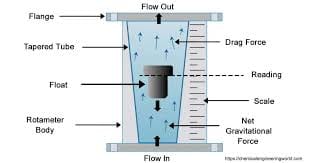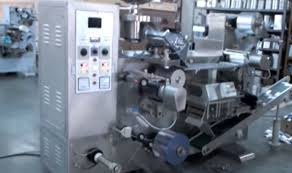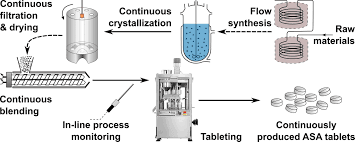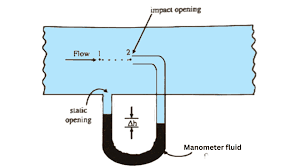|
Getting your Trinity Audio player ready... |
Understanding the Principle, Working, Construction, and Types of Rotameters
Rotameters are widely used devices for measuring the flow rate of liquids and gases in various industrial settings. Known for their simplicity, affordability, and reliable performance, rotameters are essential tools for accurately measuring fluid flow in systems where precision is crucial. This article delves into the principles behind rotameters, their construction, working mechanism, types, and applications.
What is a Rotameter?
A rotameter is a flow meter designed to measure the volumetric flow rate of liquids and gases. It consists of a tapered tube, usually made of glass or metal, with a float that moves within the tube in response to the flow of the fluid. The rotameter works based on the principle of variable area flow measurement, where the position of the float correlates with the flow rate. Sometimes referred to as gravity flow meters, mechanical flow meters, or variable area flow meters, these devices are used in a wide range of industries, including chemical, pharmaceutical, and oil production.
The key feature of a rotameter is its ability to measure flow rates without requiring external power sources, relying instead on the physical properties of the flowing fluid and gravity. This makes rotameters highly reliable and cost-effective tools for flow measurement.
Principle of Rotameter
The working principle of a rotameter is based on variable area flow measurement. The device consists of a transparent tapered tube, through which a fluid flows. Inside the tube, there is a float (also referred to as a plummet), which moves up and down depending on the rate of fluid flow.
As fluid enters the tapered tube, it pushes the float upward. The float’s movement is resisted by gravity and the drag forces exerted by the fluid. The position of the float is determined by the balance between the upward force of the fluid flow and the downward force due to gravity. When the flow rate increases, the float rises to a higher position in the tube. Conversely, if the flow rate decreases, the float falls.
The float reaches an equilibrium position where the upward flow force equals the downward gravitational force, and this position correlates with the flow rate. The scale on the side of the tube allows the user to directly read the flow rate based on the position of the float.
Construction of Rotameters
The basic construction of a rotameter includes several key components that make it effective for flow measurement. Here’s a breakdown of its main parts:
Tapered Tube: The tube is the core component of the rotameter and is usually made from transparent materials like borosilicate glass or metal. The tube is conical, with the wider end at the top and the narrower end at the bottom. This design ensures that the float’s position corresponds to the flow rate.
Float/Plummet: The float inside the tube is typically made from materials such as aluminum, lead, plastic, or stainless steel, depending on the type of fluid being measured. The float has a shape that allows it to be suspended in the flow path and is free to move vertically in response to the fluid flow.
Scale: A linear scale is usually attached to the side of the tapered tube. The scale helps measure the position of the float, which directly correlates with the flow rate of the fluid passing through the tube.
End Fittings: The rotameter is fitted with inlet and outlet connections at either end of the tube. These fittings allow the fluid to enter and exit the tube and are typically attached to pipelines or tanks.
Working of Rotameters
The working of a rotameter can be explained step by step:
Fluid Flow: When the fluid enters the tapered tube, it flows upward, pushing the float upward in the process. The flow rate influences how much the float rises.
Upward and Downward Forces: As the fluid flows, two forces act on the float:
Upthrust force: The flow of fluid creates an upward force, pushing the float upwards.
Gravity force: Gravity pulls the float downward.
Equilibrium: The float moves upward until it reaches a position where the upward force from the fluid flow is balanced by the downward gravitational force. This position is determined by the flow rate.
Flow Measurement: The position of the float in the tapered tube correlates with the flow rate. The scale attached to the side of the tube allows the user to directly read the flow rate based on the height of the float.
Reading the Flow: The flow rate can be measured by observing the upper edge of the float (or plummet) against the scale, providing a visual indication of the flow rate.
Types of Rotameters
Rotameters come in several types, each suited for specific applications based on factors such as fluid type, temperature, pressure, and required accuracy. Below are the three main types of rotameters:
Glass Tube Rotameter:
Construction: Made from transparent borosilicate glass, glass tube rotameters allow the user to visually inspect the position of the float, making them easy to use.
Applications: These rotameters are ideal for measuring the flow of clean, non-corrosive liquids and gases in low to moderate pressure systems.
Limitations: Glass tube rotameters cannot be used for fluids above 90°C (although some models can withstand temperatures up to 120°C) and should not be used for caustic soda or hydrofluoric acid due to the risk of damage to the glass.
Metal Tube Rotameter:
Construction: These rotameters are made from durable metals such as aluminum, brass, or stainless steel. Unlike glass tube rotameters, metal tube versions are not transparent, so they require external indicators (such as a mechanical or magnetic float indicator) to measure flow.
Applications: Metal tube rotameters are ideal for measuring the flow of high-temperature fluids, such as steam, hot water, or corrosive substances like acids and alkalis.
Advantages: These rotameters are designed for higher pressures and temperatures and are suitable for rugged industrial environments.
Heavy-Duty/Industrial Pressure Transducers:
Construction: These are designed for use in harsh industrial environments, where high pressure, high temperature, and electrical noise are prevalent. These rotameters often come with pressure transducers that provide an analog output (such as 4-20mA) for remote monitoring and control.
Applications: Used in demanding industrial processes where precision and durability are crucial, these rotameters are built to withstand extreme conditions.
Applications of Rotameters
Rotameters are widely used across various industries due to their simplicity and cost-effectiveness. Some common applications include:
Chemical Industry: Used to measure the flow of reactants and products in chemical reactions.
Oil and Gas: Essential for monitoring fluid flow in pipelines and refineries.
Medical Field: Used to measure the flow of gases like oxygen and nitrous oxide in medical equipment and ventilation systems.
Pharmaceuticals: In production processes requiring precise fluid measurements.
Water Treatment Plants: To monitor water flow rates in purification systems.
Advantages and Disadvantages of Rotameters
Advantages:
No External Power Required: Rotameters function using only the inherent properties of the flowing fluid and gravity, making them power-efficient and cost-effective.
Simplicity and Affordability: They are relatively simple to manufacture and inexpensive compared to other flow measurement devices.
Versatility: Suitable for a wide range of fluids, including gases and liquids.
Easy to Read: Visual indicators make reading the flow rate straightforward.
Disadvantages:
Limited Size: Rotameters are generally not manufactured for pipes larger than 6 inches in diameter, though bypass designs can be used for larger pipes.
Accuracy: Rotameters offer an accuracy range of ±0.5% to ±10%, which might not be suitable for highly precise applications.
Fragility: Glass tube rotameters can be easily broken if mishandled, making them less suitable for harsh environments.
Manual Reading: Most rotameters require manual reading, which can be cumbersome in automated systems.
Conclusion
Rotameters are crucial devices in flow measurement, offering a reliable and simple solution for monitoring the flow of liquids and gases in industrial applications. Their transparent, tapered tubes, combined with a floating float, make them a valuable tool for ensuring accurate fluid flow measurements. While rotameters have their limitations in terms of size and accuracy, they are still widely used due to their affordability, ease of use, and low maintenance requirements.
FAQs
Q: What is the difference between a rotameter and a flow meter?
A: The terms “rotameter” and “flow meter” are often used interchangeably. A rotameter is a type of flow meter, specifically a variable area flow meter that uses a tapered tube and a float to measure the flow rate of a fluid.
Q: Can a rotameter be used for high-pressure applications?
A: While glass tube rotameters are not typically suitable for high-pressure applications, metal tube rotameters and industrial pressure transducers are designed to handle higher pressures and temperatures.
Q: How do you read the flow rate on a rotameter?
A: The flow rate is determined by reading the position of the float against the scale on the side of the tapered tube. The higher the float rises, the greater the flow rate
















Leave a Reply